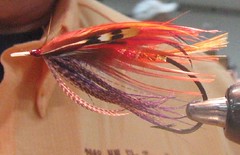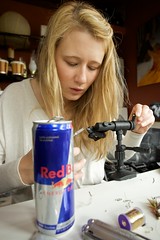 Steve Brocco Tri-Color (steelhead fly) (Photo credit: andrewb823)
Steve Brocco Tri-Color (steelhead fly) (Photo credit: andrewb823) Image via Wikipedia
Image via Wikipedia Image via Wikipedia
Image via Wikipedia Image via Wikipedia
Image via Wikipedia Image by TenkaraAshley via FlickrOne of the best parts of fly fishing is learning the art of fly tying. While you can buy pre-made flies, there’s nothing more satisfying than tying your own flies and being able to share with your friends the fact that you caught a 20 pound fish using a fly you made yourself. While it’s not complicated, fly tying for fly fishing can be a very delicate art.
Image by TenkaraAshley via FlickrOne of the best parts of fly fishing is learning the art of fly tying. While you can buy pre-made flies, there’s nothing more satisfying than tying your own flies and being able to share with your friends the fact that you caught a 20 pound fish using a fly you made yourself. While it’s not complicated, fly tying for fly fishing can be a very delicate art.The first piece of equipment you will need when undertaking fly tying is a fly vice. These hold your hook while you are tying it together. You’ll want a vice that can hold all sizes and shapes of hooks and that is easily adjustable.
Get a bobbin that will hold your thread. A bobbin will keep your thread tight and organized while you are tying your fly. Bobbins come in a variety of sizes, but they all basically do the same thing. Spend just a little bit more money on a bobbin and you won’t have to worry about cut threads before you are through.
You need to also splurge on a good pair of scissors. To start out with, one pair of scissors is enough, but as you get better at fly tying, you’ll want to have a variety of shapes and sizes to meet the needs of the flies you are tying. The loops should fit your fingers comfortably, and they should be kept sharp.
Hackle pliers are small pliers with enough constant tension designed to wrap hackle feathers around the hook. As with scissors, they come in all shapes and sizes, but they all do basically the same thing.
Find a good bodkin too. A bodkin is basically a needle in a handle. You can use a bodkin not only to tie the fly, but also for delicate work that requires a small, sharp point like separating out pieces of feather and fur.
Of course, you’ll also need a large selection of feathers and fur to match the different types of flies you want to match. Mink fur and pheasant feathers are good materials to work with as are peacock feathers.
There are several books and websites available that can teach you fly tying for fly fishing as it can’t really be explained in a few short paragraphs. The best way to learn how to tie your fly fishing ties is to experiment and keep doing it. You’ll eventually find techniques that work for you and be well on your way to becoming an expert on fly tying for your fly fishing needs!

No comments:
Post a Comment